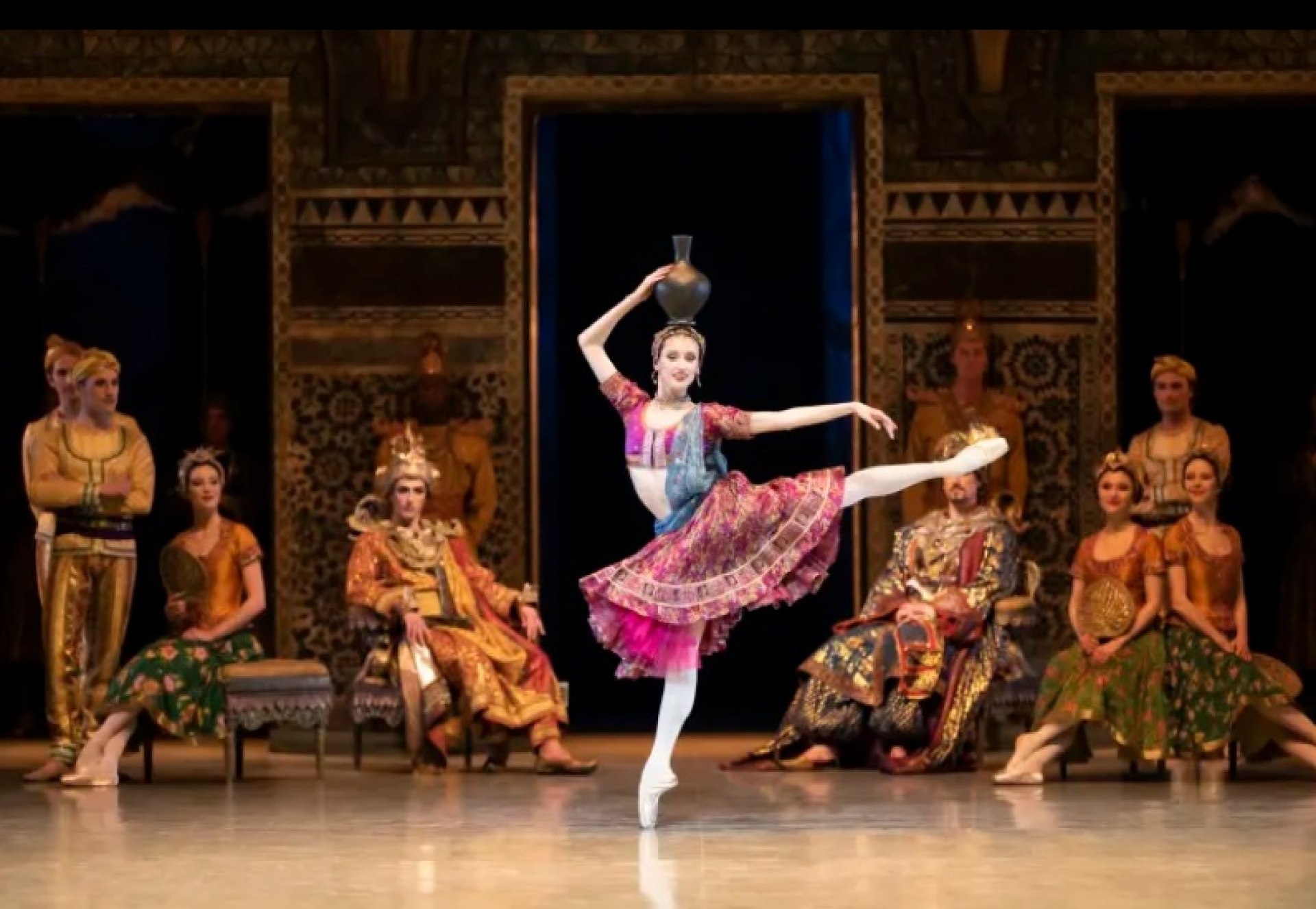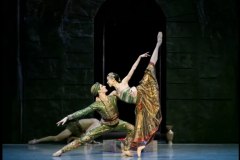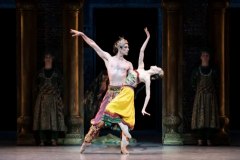La Bayadère
Mo | Tu | We | Th | Fr | Sa | Su |
Ballet
Duration : 2h45 with 2 intervals
Opening:
First part 40 minutes
Intermission 20 minutes
Second part 45 minutes
Intermission 20 minutes
Third part 40 minutes
End
It was on the stage of the Palais Garnier that dancer Rudolf Nureyev revealed himself to Western audiences in 1961, and on the same stage that the choreographer greeted the public for the last time in 1992, with his version of La Bayadère.
His final ballet, adapted from Marius Petipa’s own version, reflects Nureyev’s passion for the great repertoire ballets and his taste for flamboyance.
In an imaginary India, where a gigantic elephant parades in front of the rajah’s sumptuous palace and a golden idol follows a fan dance, the ballet tells the story of the thwarted love between the warrior Solor and the bayadère Nikiya, a sacred dancer.
A jewel in the crown of the Paris Opera’s repertoire, La Bayadère dazzles with its virtuoso variations, impressive ensembles and the purity of its “Kingdom of the Shades” scene, during which 32 dancers in white tutus slowly trace their arabesques with a poetry bordering on magic.
CHARACTERS
Solor: A noble and valiant warrior from the Indian kingdom of Golconda. He is in love with Nikiya.
Nikiya: Temple dancer and guardian of the Temple’s sacred fire. She is in love with Solor.
The High Brahmin: High priest of the temple. He is secretly in love with Nikiya
The Rajah of Golconda: Monarch of the kingdom, father of Gamzatti. He wants her to marry Solor.
Gamzatti: The daughter of the Rajah of Golconda and Solor’s fiancée.
The Kshatriyas: Friends of Solor and members of the caste holding temporal power.
The Slave: Dances with Nikiya at the betrothal of Gamzatti and Solor.
Aiya: Gamzatti’s servant.
The Golden Idol: Incarnation evoking the god Shiva, holding the position of the lotus flower.
The Shades: The ghosts of dead bayadères
First part
Act 1:
First scene: in front of the temple
The noble warrior Solor, eager to offer the Rajah a tiger’s hide, sends his friends out hunting whilst he stays near the temple in the hope of secretly meeting his sweetheart the bayadère Nikiya, one of the temple dancers guarding the sacred flame.
The Grand Brahmin confesses his love to Nikiya. Shocked by the declaration, the bayadère reminds him that he is a priest and a high-ranking dignitary while she is merely a temple dancer. She rejects him.
The Dance of the daggers. The fakir and the Hindus mortify themselves.
When Nikiya serves a drink to the fakir she learns that Solor is nearby and that once the ceremony is over he will come to find her. Solor swears over the sacred flame that he will always love Nikiya. The Grand Brahmin stumbles upon them and is consumed with jealousy. The fakir alerts Nikiya and Solor to the presence of the priest. They go their separate ways. The Grand Brahmin vows revenge.
Second scene: Inside the Rajah’s palace
The Rajah of Golconda throws a party in honour of his daughter Gamzatti, who will soon be married to Solor. He invites the Kshatriyas, friends of Solor. The Djampo Dance (with veils attached to the ankles of the dancers).
The Rajah summons his daughter Gamzatti and introduces her to Solor, whom he wants her to marry. Solor, wanting to remain true to his oath to Nikiya, would like to refuse but he must obey the Rajah, who has invited the temple dancer Nikiya to perform to bless the betrothal. The Adagio of Nikiya with the slave (musical interpolation by Cesare Pugni).
Troubled and embarrassed, Solor hides so as not to be seen by the temple dancer.
The Grand Brahmin comes to inform the Rajah of the romantic relationship between Solor and the temple dancer Nikiya. Furious at seeing his plans thwarted, the Rajah decides to rid himself of the bayadère. The Grand Brahmin, who was hoping to undermine Solor, had failed to anticipate the disaster that would befall Nikiya. Gamzatti, overhearing the conversation, summons Nikiya in order to show her the portrait of her future husband. Nikiya realises with horror that it is Solor but refuses to believe that he has betrayed her. The two rivals quarrel. Gamzatti goes so far as to offer jewels to Nikiya if she will renounce Solor. Nikiya rushes at Gamzatti with a dagger but the servant Aiya holds her back. Gamzatti considers getting rid of the insolent bayadère.
Second part
Act 2:
The betrothal of Gamzatti and Solor
The Rajah has invited his people to celebrate his daughter’s engagement.
A series of dances follow.
The Wedding Procession.
The Fan Dance.
The Parrot Dance.
The Children Entrance.
The Golden Idol Variation.
The Manou Dance (a young girl with a jug balanced on her head).
The Indian Dance.
During the festivities, Nikiya has to dance before the guests. Aiya, Gamzatti’s servant, presents the bayadère with a basket of flowers. It conceals a snake which fatally bites Nikiya. The Grand Brahmin offers Nikiya an antidote to the poison if she surrenders herself to him. Seeing Gamzatti holding back Solor, Nikiya lets herself die after calling on the gods to curse those responsible for her demise.
Third part
Act 3:
First scene: Solor’s room
In despair at Nikiya’s death, Solor takes refuge in opium-fuelled dreams.
Solor’s Variation.
Dance of the Hindus: Solor enters the realm of dreams.
Second scene: The Shades
In a long hypnotic procession, the Shades, ghosts of dead bayadères, appear before Solor: among them, he sees Nikiya who forgives him. And in the dream they are reunited again.
Program and cast
Ballet in three acts
Creative team
Rudolf Noureev: Choreography after Marius Petipa
Ludwig Minkus: Music(1826‑1917)
Marius Petipa: Libretto
Sergueï Khoudekov: Libretto
Koen Kessels: Conductor
John Lanchbery: Adaptation, arrangement
Ezio Frigerio: Set design
Franca Squarciapino: Costume design
Vinicio Cheli: Lighting design
With the Paris Opera Étoiles, Premières Danseuses, Premiers Danseurs and Corps de Ballet
With the participation of students of the Paris Opera Ballet School
The Paris Opera Orchestra
Paris Opera Bastille
RM Europa Ticket GmbH is an officially accredited ticket reseller of/by Opera National de Paris.
Agency number: 4848428
Opéra Bastille
A great modern theatre
The Opéra Bastille is the work of the Canadian-Uruguayan architect Carlos Ott, who was chosen in November 1983 after an international competition that attracted entries from some 1,700 architects. The theatre was inaugurated on July 13th 1989.
Its architecture is marked by transparent façades and by the use of identical materials for both the interiors and the exteriors.
With its 2,700 acoustically consistent seats, its unique stage facilities, its integrated scenery, costume and accessory workshops, as well as its numerous work areas and rehearsal rooms, the Opera Bastille is a great modern theatre.
Stage facilities
Orchestra pit, mobile and adjustable, can be covered; at its largest it can house 130 musicians
Main stage, 45 m high, 30 m wide, 25 m deep, made up of 9 elevators allowing several levels to be created and supported by three main elevators, which bring scenery up from below stage
Clearing zones, 4 storage areas with the same dimensions as the stage
Backstage area, with its scenery turntable
Circulation area, scenery temporarily stored between the stage, workshops and rehearsal stage
Rehearsal stage, the Salle Gounod, with its orchestra pit and dimensions identical to those of the main stage
The building
Area at ground level: 22,000 m²
Floor area: 160,000 m²
Total height: 80 m (including 30 m below street level)
The auditoriums
The main auditorium
Area: 1,200 m², 5% of the total for the building
Dimensions: 20 m high, 32 m deep, 40 m wide
Number of seats: 2,703
Materials: blue granite from Lannelin in Brittany, pearwood from China, glass ceiling
The amphitheatre
Area: 700 m²
Depth : 21.4 m
Number of seats : 450
Materials: white breccia marble from Verona, staff ceiling
The Studio
Area: 280 m²
Depth: 19,5 m
Number of seats: 237
Materials: white breccia marble from Verona and pearwood

 EN
EN DE
DE IT
IT FR
FR ES
ES RU
RU JP
JP RO
RO
 Seating plan
Seating plan 


